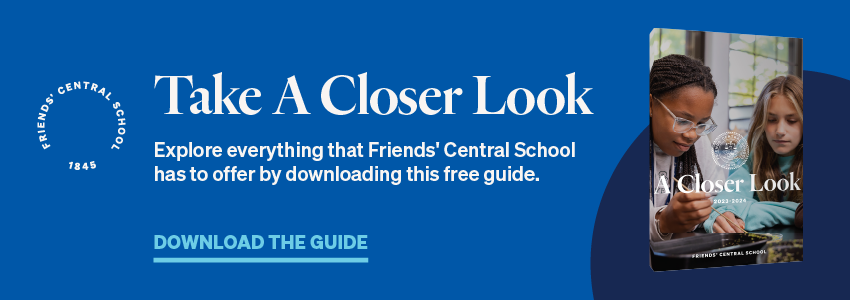.jpg?width=848&name=learning-by-doing-in-schools-(insert-feature).jpg)
As parents and caregivers explore options for their child’s school, they may encounter many new concepts and styles of learning that they will need to consider. Parents will no doubt want to ensure that their children are growing academically and personally, but also exploring their passions and interests—and having fun!
One common, and very effective form of learning parents will no doubt encounter is known as experiential learning, and it’s a concept that they are likely already employing at home. The hands-on, explorative nature of experiential learning can be found when parents let their children help them cook dinner, write to relatives, race one another down the street, or even act out scenarios with their stuffed animals.
This continued philosophy of actively engaging young learners in activities and experiments that combine knowledge with real-world application helps ensure students are not only learning but are engaged in their educational journey.
Free Downloadable Guide: Take a Closer Look at Friends' Central School
What is experiential learning?
Experiential learning simply means learning through experience or, more simply, learning by doing.
It focuses on hands-on experiences and exercises as a way to produce more invested, well-rounded learners. This method of learning focuses on allowing individuals to practice the very concepts they need to learn in a purposeful way, to help them not only increase their knowledge but develop the skills necessary to succeed.
From young children practicing walking and talking, to older learners learning to ride a bike, cultivating a garden, and going on field trips, the opportunities for children to learn experientially are both endless and incredibly effective. This active form of learning allows students to step away from textbooks and lectures and pursue real-life areas and activities that interest and engage them on all levels; socially, emotionally, physically, and intellectually.
Why is experiential learning important in education?
Enrolling young learners in schools and programs that base their curriculum on hands-on experiential learning is key in ensuring they become well-rounded lifelong learners. Programs that rely on an experiential style of learning present activities that actively engage students in not only memorizing knowledge and material, but help them internalize the content by allowing them to:
- Craft the experiences that interest them
- Ask questions
- Investigate and experiment
- Creatively solve problems
- Take ownership and responsibility for the outcomes
This process, rather than simply asking young learners to read and memorize the information, allows students to forge a personal connection with the material they are presented with, ensuring that the knowledge they gain is planted deeply for future use and recall.
Deb Skapik, Service Coordinator at Friends’ Central School uses a simple classroom project of building a birdhouse as an example. If a student reads an article about building a birdhouse, they may ultimately be able to build one. However, the student wouldn’t necessarily remember each step, and would likely need to continually refer to the written instructions, making mistakes along the way and possibly end up unhappy with the result when it doesn’t match up exactly with the example shown.
If, however, students work on building their own birdhouse alongside their instructor, correcting their mistakes together in real-time, they will not only understand how to build a birdhouse, but they will be able to teach others how to build a birdhouse in turn.
“The experience of doing helps people retain information in a way that’s very different from just reading a paper or memorizing and spewing out facts,” she says. “Absorbing through reading may be temporary, while in some cases, experiences last forever.”
Examples of Learning By Doing
A great benefit of experiential learning is the seemingly endless list of possible activities and exercises teachers and educators can use to instruct their students. By combining content with process, educators can turn their lesson plans into opportunities to inform and engage their students.
Examples of Experiential Learning in the Classroom
Just a few examples of experiential learning in the classroom can include:
- Scavenger hunts, which require students to think critically to solve riddles and clues, and to work collaboratively with their classmates to complete their tasks. For younger learners, finding the right items to complete their search might require them to look for similarities between items, or think about how items might fit into different categories.
- Gardening and planting, which allow students the hands-on experience of adjusting conditions under which plants thrive or die. This can instill a deep understanding of concepts like photosynthesis and life cycles and give students a sense of ownership over a process they can watch develop with their own eyes.
- Engineering small projects using only found household and classroom materials. Allowing children to have ownership of envisioning their structure, thoughtfully compiling their materials and working through the process of putting them together successfully.
In Deb Skapik’s Advanced Physics course, students participate in active exercises like testing out stomp rockets and shooting marbles into carbon paper to observe trajectory and figure out which adjustments they need to make to get the path they want. They then apply their learnings to a game of basketball—something they do often and outside of school—to see how they can improve their throws. These lessons allow students to observe the principles of physics and forge connections between them and activities they enjoy and are passionate about.
Service Learning
Service learning, a part of curriculum that is important to many families, is also considered to be experiential learning. Service learning helps students forge connections with the community and world around them, and helps students move their continued learning beyond the classroom.
Service learning encourages young learners to approach the community around them with empathy and collaboration, and allows them to employ and strengthen their critical thinking and problem solving skills in a way that demonstrates their impact on the world around them.
For schools like Friends’ Central School, this idea of creating global citizens that forge positive connections with their communities is ingrained in the school culture, and service and experiential learning works seamlessly to help young learners achieve that goal.
Experiential Learning Ensures Engagement
While the idea of “experiential learning” can seem like a complex one, it’s really quite simple. It allows young learners the opportunity to “do” while learning, and explore the many ways they can apply typical school subjects to the ideas and activities they are passionate about.
In an age where distractions are everywhere, this form of learning encourages children to look away from phones and devices, and actively participate in their learning experiences. Parents and caregivers who select learning institutions that emphasize this style of learning can be assured that their children are not only gaining the critical intellectual and emotional skills necessary to succeed in the world, but are enjoying themselves in the process.



